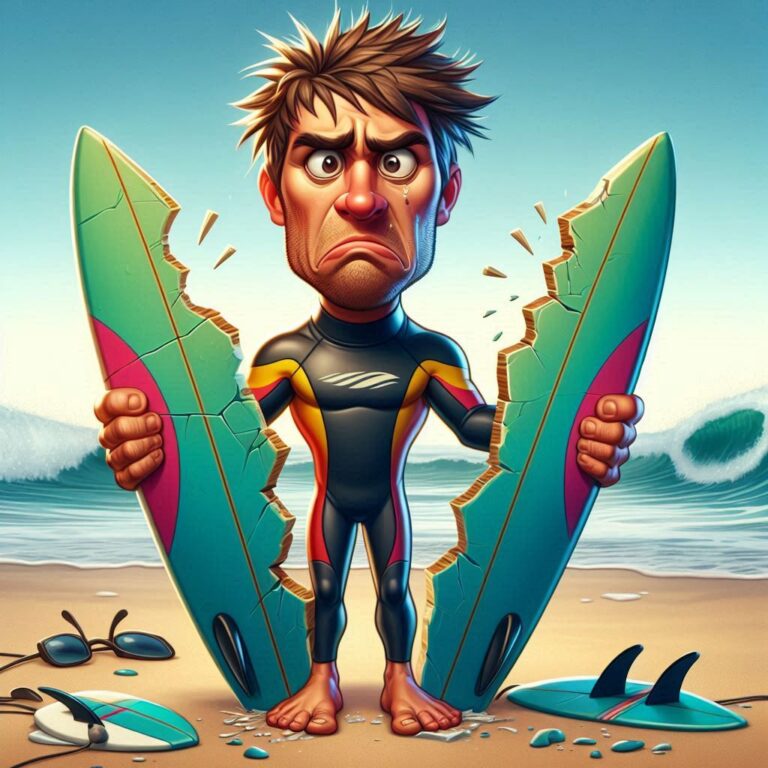Surfboards are made to be strong enough for surfers to take on the extreme sport of surfing. Surfers use surfboards to paddle, duck dive, pop up and ride waves in wave conditions big and small.
Surfboards can be somewhat fragile because common construction materials like fibreglass, foam and epoxy can become damaged.
Because surfboards can become damaged and breakage is a common discussion point, I often get asked, “Do Surfboards Break Easily?”
So I came up with an answer to that question and summarized my thoughts below.
Surfboards are made to be strong and don’t break easily when surfing small to medium waves. Surfboards are more likely to get broken when surfers wipe out in big waves, ditch their board when duck diving or run them over with a car!
To separate the discussion from dings and minor damage, this post will focus on severe breaks like when a surfboard separates into two pieces; this is every surfer’s nightmare.
How Do Surfboards Break?
Surfboards break because a strong enough force is applied to snap it in half. The most common area of a surfboard to break is in the middle, the nose, and near the tail under a surfers feet.
The 5 most common ways surfboards usually break:
- By A Wave
- By A Surfer
- Contact with the Ocean Bottom
- During Transport
- Weak Construction
1. Waves: the biggest surfboard breaker?
A wave can break surfboards in half when the powerful force of the water comes crashing down on a surfers board.
This usually occurs when a surfer gets separated from their board during a wipeout or when ditching their board to swim under crashing waves.
Usually, breaking a surfboard in half is not very common in small to medium waves but as you can see in the video, the surfboard is broken when it turn perpendicular to the wave and the full force of the wave comes crashing down onto the board.
2. Surfers Vs. surfboards
Surfers can break surfboards with their feet when they land on top of their surfboard when executing advanced tricks.
There are two advanced tricks in surfing that increase the likelihood of your surfboard being broken if you land with your feet in the wrong place, these tricks are called: airs and floaters.
An air is when a surfer launches a surfboard completely out of the water, then lands and continues riding the wave.
A floater is when a surfer rides on top of the whitewater or lip of the wave and drops back onto the wave and keeps on riding.
Check out the Video of some of the biggest floaters by the world’s best surfers. Although there aren’t any broken surfboards in this compilation, you can see how surfboards could break when being pushed to the limit!
As you can see in the Video above, expert surfers will bend their knees when landing floaters and airs to absorb the shock and spread out the forces on the surfboard.
3. Contact with the Ocean floor
Surfboards can also break when they come into contact with the ocean bottom.
This usually occurs when a surfboard becomes lodged in a crevice or space in the reef or rocks on the ocean floor and the force of the wave causes the surfboard to break in half.
It is fairly common for the nose of a surfboard to break off when it hits the reef or rock bottom. Most often, the nose of the surfboard is the narrowest and thinnest portion of the surfboard, which makes it weaker and more prone to breakage.
Surfing in shallow water increases the likelihood of your surfboard coming into contact with the bottom when you wipeout.
4. Surfboards Can Be Broken During Transport
Breaking surfboards during transport is one if the most common ways to get your surfboard in two pieces. From mishandling by baggage handlers at the airport to surfboards flying off cars on the way to the beach, you would be surprised by all the ways surfboards can break.
Quick story:
About ten years ago, some friends were on a long road trip to go surfing and stopped at a roadside pullout to sleep for the night. In order to make room in the van for sleeping bags, they put one of their surfboards under the car.
In the morning, they were woken up by someone honking a car horn. It was a person in a car behind them trying to nudge into the pullout to see a bear that was munching berries in the woods nearby.
In all the excitement, my friend jumped into the front seat, started the van and slowly drove forward. The sickening sound of cracking fibreglass helped reminded them that they had stored a surfboard under the van.
On closer inspection, the surfboard was in two pieces.
Transporting surfboards by airplane is another mode of travel that increases the likelihood of breakage. A friend of mine used to say,
“You have a higher chance of your surfboard getting broken during the flight, than surfing waves on your trip!”
Having surfboards broken during the flight happens occasionally and is massively disappointing. With the rise of social media, airline policies have improved over the last 5 years, because well known surfers have shared airline gone bad stories.
I think it has gotten a little better in the last few years because airlines are beginning to understand that broken surfboards are bad for their image.
5. Surfboard With Weak Construction Design
Not all surfboards are made to last. That may seem counterintuitive but lots of surfboards are made for high end performance and are more prone to breaking.
Professional surfers ride high end performance surfboards that are thinner and lighter in order to make it possible to do radical maneuvers. Think of a performance surfboard like a Ferrari sports car, they are made as a speed machine, not an everyday commuter.
As a result, professional surfers break a lot of surfboards. Obviously, they are pushing surfboards to the limit, but they are also riding surfboards that aren’t made for durability or longevity.
Another group of surfboards that may be prone to breaking are foam surfboards that are being marketed as the lowest cost option on the market. As the popularity of foam surfboards increases, more and more companies are producing foam surfboards.
Make sure to do your research before purchasing your next board to make sure you can get some longevity and ride it for years to come.
In Conclusion:
Surfers can become very attached to their favourite surfboards. Strangely to non-surfers, it is common to form a strong emotional connection to a board.
Which is why surfers hate breaking surfboards! Do your best and try to avoid the most common ways surfboards become broken!
Surf, have fun, repeat!
Found this interesting? Read these articles too:
Buying a Used Surfboard: 28 Money-Saving Tips
17 Tips on How to Attach a Surfboard to a Car’s Roof Rack
Is Surfing Expensive? Cost-Saving Guide




